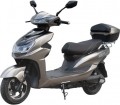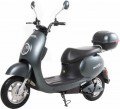Wheel size
tThe diameter of the wheels used in the vehicle. For models with wheels of different sizes, the largest diameter is usually indicated, other data can be specified in the notes.
For electric scooterbikes, the traditional size is a modest 10"; larger sizes are also found — up to
16". Among minibikes, large
18" wheels are more common. Electric motorcycles have small wheels — an average of 12 – 14". Among electric tricycles, a combination of a large front wheel with small rear wheels is often found — for example, 16 "and 4" each, respectively.
The large diameter allows you to roll over the bumps on the road, overcome rather large obstacles and maintain speed longer when coasting; on the other hand, such wheels require more torque from the engine, they accelerate worse and reduce the maximum speed of the unit. Small wheels, on the contrary, accelerate well and also provide good manoeuvrability, but they are intended mainly for flat roads.
Max. climb angle
The maximum incline that the vehicle can overcome.
Most vehicles, even the most inexpensive ones, can cope with angles of 10 – 12 ° without problems. So you should pay special attention to this parameter only if you have to deal with very steep slopes.
It is also worth mentioning that on road signs the angle of elevation is usually indicated not in degrees, but as a percentage. This means that to evaluate the capabilities of a particular unit, it may be necessary to convert degrees to percentages or vice versa. For this, there are special tables and calculators.
Wheelbase
Wheelbase of the vehicle.
This term shows the distance between the wheels, more precisely, between the axles of the wheels. This size is one of the key parameters for any motorcycle, it determines not only the overall dimensions of the vehicle but also some of the features of the movement. So, a small wheelbase reduces the turning radius and makes the vehicle more manoeuvrable; at the same time, a longer vehicle will be more stable and predictable in corners.
Battery type
—
Lead-acid. The most popular type today. Their design is based on a combination of electrodes made of lead compounds and an electrolyte, the role of which is played by sulfuric acid diluted with water. It is the classic type of batteries that use a conventional liquid electrolyte. Their widespread use is due to their simple design and low cost, combined with good capacity and starting currents characteristic of all lead-acid batteries, as well as resistance to low temperatures (compared to other types of batteries).
—
Lithium-ion (Li-Ion). Lithium-ion technology was originally used in batteries for portable gadgets such as mobile phones, but such batteries are being used more and more recently in vehicles. Among the advantages of such batteries, one can note smaller dimensions and weight, the ability to deliver high starting currents and the ability to be charged with high currents (the latter significantly reduces the charging time), as well as numerous charge-discharge cycles. In addition, such batteries contain a minimum of harmful substances, do not use acids and heavy metals, and some models are even directly positioned as absolutely harmless to the environment. The main disadvantage of lithium-ion models is the high price.
—
Gel. A type of lead-acid battery in which the electrolyte is not liquid, but condensed to a gel state. This design prov
...ides several advantages compared to the classic version (see above): more charge-discharge cycles (which means longer service life); minimum leakage of electrolyte and associated gases; no need for maintenance; resistance to deep discharges and temperature fluctuations, etc. On the other hand, such batteries cost significantly more.Weight
The total weight of the vehicle without cargo and rider.
The
lighter the unit, the greater the range and, accordingly, the weight of the payload that can be carried on it. On the other hand, too little weight adversely affects the stability, and sometimes the overall strength of the structure.

